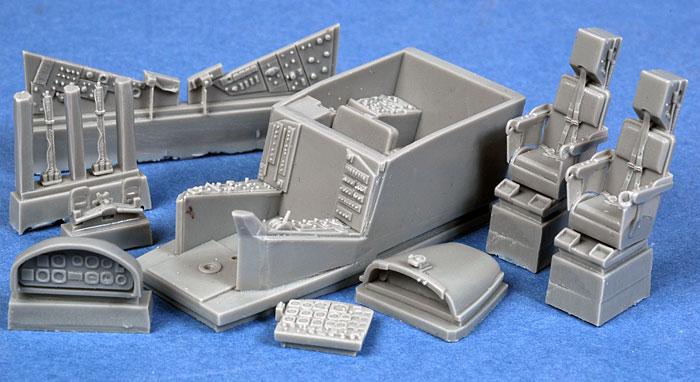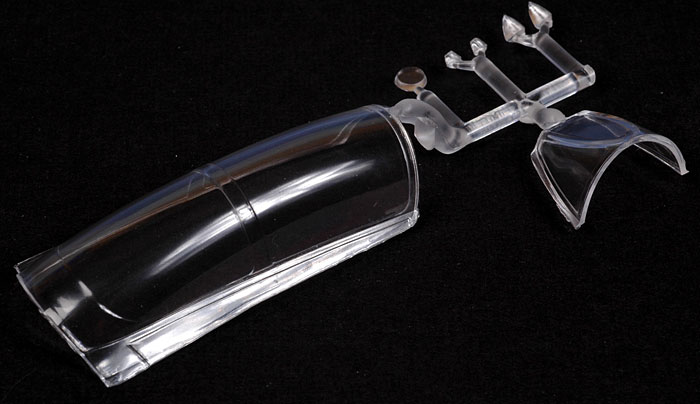|
B-57B Canberra

Classic Airframes, 1/48
scale
S
u m m a r y
|
| Catalogue Number: |
4130 - B-57B Canberra |
| Scale: |
1/48 |
| Contents and Media: |
91 parts in grey styrene; 22 parts in grey colored
resin; 7 clear injection molded parts; instructions; decal sheet and
painting guide for two aircraft. |
| Price: |
MSRP
USD$69.00 |
| Review Type: |
FirstLook |
| Advantages: |
First time available as an injection-moulded kit;
large and impressive; excellent surface detail including
crisply recessed panel lines, very high quality plastic moulding;
corrected (enlarged) wing tip tanks; impressively detailed resin parts; generally very good fit; interesting marking choices. |
| Disadvantages: |
Some modelling experience helpful for preparing
resin parts; a little extra time required for alignment and perfect fit;
DIY hardpoint drilling. |
| Recommendation: |
Highly Recommended |
Reviewed by
Brett Green

Classic Airframes' 1/48 scale
B-57 Canberra is available online from Squadron
The English Electric Canberra was a groundbreaking
aircraft when it entered service in the early 1950s. The Canberra set
and held many altitude, distance and speed records in its early years.
In addition to widespread and long service with the Royal Air Force, the
English Electric Canberra was exported to many countries including
Australia, New Zealand, Sweden, France, West Germany, India, Pakistan,
Rhodesia, Ethiopia, Argentina, Chile, Ecuador, Peru and Venezuela.
The Canberra's service record was remarkable in its
longevity, spanning from the Suez crisis to Vietnam to the Persian Gulf.
In fact, the final Canberra PR.9s in RAF service only retired earlier
this year.
The B-57B was the first specific American variant.
Differences included a revised tandem cockpit with a distinct longer
cockpit, more powerful engines and substantial increase in ordnance with
the addition of four hard points under the wings. The B-57 first entered
USAF service in August 1953, with production continuing until 1957. 403
B-57s were built during this period. The American Canberra performed its
role nobly, but suffered a high attrition rate during the Vietnam War
resulting in its withdrawal from front line service by the end of the
1960s. Canberra variants continued in service with Air National Guard
units until the late 1970s.
Classic Airframes' 1/48 scale B-57 Canberra kit
may, at first glance, appear to have a lot in common with the earlier
releases, but in fact it is a substantially new kit. The B-57 kit
includes an all new nose section, revised rear fuselage halves (with the
supplementary air brakes scribed in place), wings with revised engine
nacelles and provision for hard points, ample stores and weapons, plus
mostly new resin parts.
The complete kit comprises 91 parts in grey
styrene; 22 parts in grey colored resin; seven clear injection molded parts; instructions; plus a decal sheet and painting guide for
four aircraft.
Plastic parts are presented to a very high standard.
Moulding quality is excellent, and the highly polished finish does not
reveal any moulding imperfections on the exterior surfaces. Panel lines are crisply recessed,
consistent and very fine.

Click
the thumbnails below to view larger images:
The long fuselage is split into two halves for the main section and
another two for the nose. The slab-like wings
are supplied in two halves (upper and lower) each.
Some of the new plastic parts include the wing hard points, bombs,
drop tanks and various external aerials. The locating positions for the
wing hard points are indicated by indents. These should be drilled out
before installing the hard points.
It is pleasing to see that the wing tip tanks, which were apparently
too small in earlier releases, have been completely replaced with larger
units.
Although there are no locating pins on the main parts, the wings are reinforced with
two plastic spars. This will add rigidity
and ensure the correct dihedral. There are a few tall ejector pins on
the inside surfaces of the wings that should be sliced off prior to
assembly, but the remaining scars will not be visible after assembly.
The inner lip of the intakes also have ejector pin marks. These need a
bit more time and care in cleaning up.
Resin parts are very nicely detailed. The bulk of these details are
for the cockpit, including the main tub positively bristling with
switches and fuses, plus two lovely ejection seats. Construction of the
more conventional B-57 cockpit will be simpler than the British
variants, and there should be plenty of space for nose weight.

The undercarriage bays, wheels and intake fans / starter bullets
(newly tooled) are
also supplied in resin. The gear bays are immaculately detailed with structural features and
wiring. It is just a shame that so little of this detail will be seen
under the low-slung Canberra airframe. The front wheels are all new.

Some of the parts are cast onto stout blocks so a combination of a
good razor saw and caution will be required when preparing these resin
components.
Clear parts are well moulded and relatively distortion free. The long
canopy is supplied with a separate windscreen, so the cockpit may easily
be displayed if desired.

The shape of the model looks accurate compared to published plans and
contemporary photographs.
Markings
Four marking options are offered on the decal sheets. These are good
representations of the schemes used during the B-57B's service life:
-
B-57B 13th TBS, 35th TFW, Vietnam
1966, finished in typical four-colour SEA camouflage.
-
EB-57B, 117 DSES, 190 DSEG, Air
National Guard circa June 1978, finished in overall light grey with
Dayglo Orange panels.
-
B-57B, 498th BS, 345th BW, circa
1957, finished in overall Gloss Black
-
B-57B, 501st BG, 345th BW, Kangley
AFB, circa 1954, finished in overall natural metal.
Click the thumbnails below to view larger images:
Decals are printed in perfect register, and colours look good.
Classic Airframes' 1/48 scale B-57B Canberra is a big, impressively
detailed, accurately shaped kit. With a recommended price of USD$69.00,
it is good value too, especially considering the extensive resin
included.
The relatively small parts count reflects the simple design of the
airframe, but does not compromise detail. It certainly does speed
construction though!
Granted, this model will need a little more cleanup
and preparation of parts than a long-run release from Tamiya or Hasegawa.
Also, the lack of locating pins will call for extra care and
dry-fitting. In other words, modelling skills are required, but
anyone who has already built a Classic Airframes kit should not have any
trouble coming up with a great result straight from the box.
I have already built Classic Airframes' 1/48 scale Canberra B.2 and
T.17 kits, and I can
confirm that fit is generally very good. You can
follow
this link to see construction comments and progress photos of
the B.2 kit. With a little extra
time spent on preparation and alignment, both kits were a real pleasure to work on.
If you want one of these kits though, you'd better not dawdle. The
earlier Canberra releases have sold out quickly and being limited run
offerings, once they're gone, they are gone.
Highly Recommended to experienced modellers.
Thanks to
Classic Airframes for
the review sample.
Classic Airframes
kits are available worldwide through hobby retailers and from
Squadron.com
Review and Images Copyright © 2006 by
Brett Green
Page Created 14 December, 2006
Last updated 21 February, 2007
Back to HyperScale Main Page
Back to Reviews Page
|
Home | What's
New | Features
| Gallery |
Reviews | Reference
| Forum
| Search